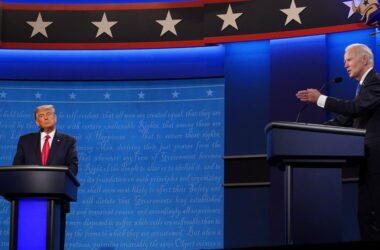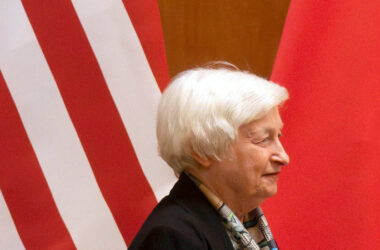California is taking some of the world’s biggest energy companies, including Shell, Exxon Mobil and Chevron, to court, accusing them of concealing the damage caused by fossil fuels on the state for more than half a century. The state’s lawsuit is the most significant attempt to take on Big Oil over its role in climate change, as the energy majors report bumper profits and oil nears $100 a barrel.
The strategy has echoes of an earlier fight: states’ legal battle against Big Tobacco in the 1990s.
California wants the companies to cover costs of fighting wildfires and mitigating the effects of dense smog. It argues that the oil majors should pay fines for burying scientific evidence linking carbon emissions to greenhouse gases. “It’s time they pay to abate the harm they have caused,” Rob Bonta, California’s attorney general, said in a statement.
The American Petroleum Institute, the industry lobbying group also named in the case, called the suit “meritless” and “an enormous waste of California taxpayer resources.”
California is reopening a playbook it used to take on Big Tobacco. In the 1990s, California and dozens of other states brought cases against the four biggest U.S. tobacco companies. Prosecutors proved that the companies had concealed evidence linking smoking to cancer, winning a payout of more than $360 billion over 25 years. The companies were also compelled to label cigarettes as potentially lethal, to change how and where they marketed them, and to disband the Tobacco Institute, the industry-funded trade group.
There are historic links and echoes between the behavior of Big Tobacco and Big Oil. In the 1950s and 1960s, oil companies helped the tobacco industry test poisons in cigarettes. And then there was a 1968 report commissioned by the American Petroleum Institute and conducted by the Stanford Research Institute. It detailed how fossil fuels caused climate change but was never widely distributed, said Carroll Muffett, C.E.O. and president of the Center for International Environmental Law, who has studied the links between the two industries.
Collective action worked. For years, individual plaintiffs had repeatedly lost lawsuits to Big Tobacco. “It was only when the states as litigators got involved that the landscape changed dramatically,” Muffett said, adding that “you had litigators who had the resources and patience to stay in litigation as long as the companies.”
California has outsize political clout as the world’s fifth-biggest economy and a major oil producer. It has used that power to, for example, shape quasi-national policy on reducing auto emissions. And this month, the State Legislature passed a bill that would force big companies to detail their carbon emissions — a first by a U.S. state and a leap ahead of the Securities Exchange Commission, which is drafting its own climate disclosure rules for companies to follow.
The oil majors face lawsuits elsewhere. Cases in the Netherlands, Britain, France and Italy argue that the industry bears some responsibility for climate change, and similar litigation is underway in New York, Massachusetts and Rhode Island. “The diversity of claimants is growing apace,” said Paul Benson of ClientEarth, an environmental law organization in London, who led a lawsuit against Shell’s board this year alleging that the company wasn’t reining in carbon emissions fast enough.
Victory is far from certain. Prosecutors could face a tougher task proving oil companies’ climate culpability than their predecessors did linking smoking to harmful health effects. In July, a British judge blocked ClientEarth from proceeding with its case against Shell, saying courts should not interfere with corporate strategy; the organization is appealing the decision.
Others could join the fight now that California is involved. With tobacco, smaller states launched their own lawsuits after an initial action filed by Florida. “Once the litigation against the tobacco industry began, it never ended,” Muffett said. — Vivienne Walt
IN CASE YOU MISSED IT
The U.A.W. widens its strike. One week after 13,000 workers walked off assembly lines at three plants owned by the Big Three Detroit automakers, the United Automobile Workers expanded its walkouts on Friday to 38 spare-parts distribution centers at General Motors and Stellantis, the parent of Jeep and Ram. The union said it was not striking more facilities at Ford Motor because of the gains it had achieved in talks with that company.
Rupert Murdoch announces his retirement. The 92-year-old media tycoon will become chairman emeritus of Fox and News Corporation and named Lachlan, his elder son, as heir. But he isn’t about to disappear: He remains the majority shareholder of a family trust that owns significant stakes in each business.
The Fed forecasts higher rates. Jerome H. Powell, the chair of the Federal Reserve, said the central bank would keep interest rates on hold at its meeting this past week, but stayed open to another increase this year. The decision, along with the Fed’s roundly optimistic economic forecasts, suggests that officials see a better chance of a “soft landing” for the economy, with higher rates neither crashing the labor market nor pushing the United States into a recession.
FTX sues Sam Bankman-Fried’s parents. Lawyers for the bankrupt cryptocurrency exchange accused Joe Bankman and Barbara Fried, two longtime Stanford law professors, of enriching themselves with money that their son, FTX’s founder, stole from customers. Lawyers for Bankman and Fried have called FTX’s claims “completely false” and “a dangerous attempt” to “undermine the jury process just days before their child’s trial begins.”
A college sports giant pulls off an unlikely deal
Over five decades, Learfield Communications has built itself into one of the biggest players in the business of college sports. The company, which assembles deals for audio streaming and in-stadium advertising and runs ticketing, among other services, racked up debt in large part to expand through acquisitions. Most recently, Learfield merged with its top rival, IMG College, to create a behemoth that works with nearly 200 Division I schools and conferences.
That aggressive deal-making, along with unprofitable rights contracts with five schools including U.C.L.A. and Florida State, landed the billion-dollar business in big trouble after the pandemic shut down college sports: With $1.1 billion in debt coming due this year, Learfield faced a potential bankruptcy.
To avoid that fate, it pulled off an unconventional maneuver that involved getting 100 percent of its creditors on board with a restructuring plan.
Learfield feared that bankruptcy would damage its reputation with colleges, and its chief executive, Cole Gahagan, pushed back against advisers’ suggestion that the company at least threaten a Chapter 11 filing to win concessions. “The notion of something in the courts was never something we had talked about doing,” he told DealBook.
Months of tough negotiations followed. The existing owners, including the entertainment giant Endeavor, agreed to give up nearly all their stakes. Dozens of creditors were jawboned into converting the debt they were owed into equity stakes in Learfield. And over two weeks, Gahagan flew across the United States to the five schools whose contracts needed reworking, pleading with them to exchange guaranteed payouts for revenue-sharing deals. (Some schools were given the chance to look elsewhere for contracts with better terms.)
Part of the pitch to creditors, Gahagan said, was that Learfield would capitalize on changes in the college sports business. Its fastest-growing business is endorsement deals, which the N.C.A.A. began to allow for student athletes and their schools in 2021.
Throughout, advisers worried that the plan would fail. Not threatening bankruptcy might have emboldened creditors to hold out for better terms, and restructuring deals negotiated outside court requires every lender to sign on. (Filing for bankruptcy after getting a majority of creditors on board allows companies to force a deal onto the others.)
Learfield got 93 percent of creditors on board by late summer. It wasn’t until days before nearly $150 million in debt was coming due in September that Learfield secured 100 percent approval for its plan: Creditors agreed to wipe out $600 million of the company’s debt and convert their holdings into ownership stakes, while putting in $150 million in new money.
Anup Sathy, Learfield’s lead outside restructuring lawyer, told Gahagan that the company’s highly unorthodox approach had made him rethink his tactics. Gahagan laughed and responded, “I wasn’t trying to make history, dude.”
Beer-flation, Bavarian style
Revelers have converged on Munich for Oktoberfest, and inflation is again the loaded topic. The cost of a liter of Bavarian beer served at the annual festival has soared, a decades-long trend that has grown more acute during the current cost-of-living crisis.
The price of a liter — or “mass,” as it’s called locally — is eye-watering. It ranges from 12.60 euros to €14.90 (about $13.40 to $15.90), according to organizers in the German city, or 6.1 percent more than last year. The most pricey: A liter of Weinzelt, one type of weissbier, spills over at €17.40 (about $18.50).
The beer-flation is enough to “make some crave a stiffer drink to drown the financial pain,” wrote Holger Schmieding, the chief economist at Berenberg, in a research note examining Oktoberfest prices. (Schmieding coined “fun-flation” this summer to describe how consumer splurging on expensive meals, concerts and through-the-roof airfare affected prices.)
The stein-half-full take for Oktoberfest: German wages have risen, on average, 6.6 percent in the past year, outpacing beer prices. “For the first time in decades, beer at the Oktoberfest is becoming slightly more affordable in real terms for most Germans,” Schmieding wrote.
Thanks for reading! We’ll see you Monday.
We’d like your feedback. Please email thoughts and suggestions to dealbook@nytimes.com.








